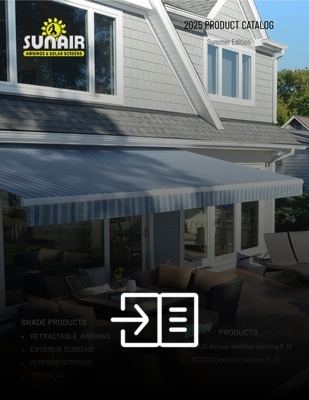The desire for a “screened porch” to protect you and your family from the elements and those pesky mosquitos has been a popular must have option for homeowners for generations. They have been designed and built the same way for many years, with a permanent porch roof, and metal screen material permanently fastened to dimensional wood lumber posts and headers. A screened door would be added for easy access to the space, The popularity of screens in porches has not changed, but what has changed is the way these screened in porches are designed and constructed. A screened in porch has always been a big improvement and project, and still is today. The difference is that now it is quickly becoming popular to install “Retractable Bug Screens” in place of the permanent mesh screen material that was typically nailed or stapled onto the wood. These new screen options basically consist of a metal cassette housing that houses a manually operated or motorized roller tube on which the mesh fabric rolls up or down depending on if you want the screen up or down. When the screen is fully retracted, the cassette housing protects the fabric inside the cassette when the screen is not in use. Special zippered tracks run down each porch post on each side, that retains the fabric inside, so mosquitoes or bugs can’t come into the space when the screens are in a down position. It is essentially the screened in porch you know, but with the ability to fully retract the screens on demand to convert the space into an open porch.
The type of fabric you choose for the roll down screens will depend on the primary purpose of the screens. A more open mesh is more for view and mosquito control, a more closed mesh is more for sun and glare control. A more closed mesh screen fabric will of course also help protect you from mosquitoes. Instead of mesh fabric, you can also use solid vinyl fabric. A solid vinyl fabric and clear crystal windows are more for use during inclement rainy and colder weather. Sunair has many model screens and fabric options depending on your budget and your needs. Each type of product has something different to offer.
In essence, todays screened in porch has evolved into what we call the “Outdoor Room”. The outdoor room and outdoor living have also evolved over the years. It has become more than just an outdoor area to drink a morning coffee or get a breath of fresh air while enjoying your garden. Today’s outdoor spaces are designed to create a seamless extension of the indoor living space to the outside. By creating this “Outdoor room” as it is commonly called, you can transform your outdoor living space into an oasis you, your family, and friends can enjoy for years to come. By having the screens retractable, you have full control, and can enjoy a more open space and experience when the elements and weather allows.
It takes a little planning and design work to install retractable screens on a Porch. The header cassette is typically face mounted on a wood header beam on the outside of the porch, or ceiling mounted underneath the wood beam. When the screens are face mounted, the tracks typically are installed also on the face of the posts or pillars. When the cassette housing is ceiling mounted underneath the wood opening beams, the tracks are typically mounted to the side of the posts or porch pillars. You need to make sure you have plenty of wood to support bolting the housing / cassette. The cassette weighs about 8 lbs. per ft, and a motor will add to the weight a bit also. You want to make sure you have straight lines and open surfaces, that are straight and square. On older porches, sometimes the width opening is different at the top than on the bottom. Sunair has U channel compensator profiles that can usually compensate for an uneven opening. So, most of the time it is usually possible to easily install the screens on the porch.
The Sunair retractable screen system is also sometimes installed on an existing screened in porch with already installed fixed metal mesh screening. Typically, then the screens are added not to control pesky bugs, but to control sun and glare. Also, in some cases it may even be necessary and simpler to install the screen on the inside of the porch, if there is no room on the outside header and major re-work of the porch is not conducive. It is important to note that if you are adding mesh screens outside of an already screened area, you must use a denser twill weave fabric. This is called the moiré effect, and you will get dizzy looking through two basket weave mesh fabrics.
Instead of building a porch and adding screens, some homeowners will elect to install a Pergola awning. A pergola awning is a structure that can be mounted to the house, or as free standing in your yard. Sunair offers two types of Pergola awnings. The fabric pergola awnings have a retractable fabric “roof” that opens like a roman shade. The two primary fabric pergola roof models are the Level and Nomo models by Sunair. Choosing one over the other will depend on the look you desire as well as your budget, and how large of an area you need to cover. The Opera and Vision motorized adjustable louvered roof pergolas have metal horizontal louvers that at the touch of a button, automatically adjust the louvers to the sun’s angle. It allows you to open the roof for full sun, close the louvers to control the amount of shade, or close the roof completely for a weather-tight seal in the rain and snow. A pergola awning offers the same relaxing space that you would expect of your screened in porch, but with the added benefit of natural light and some breeze from the outside. In some cases, you don’t need a permit to install the Pergola awnings. And as with a porch you can add roll down screens, LED lights, and heaters.
Designing the perfect screened in porch with Mastershade retractable screens by Sunair
Mon, February 05, 2024


.jpg)














